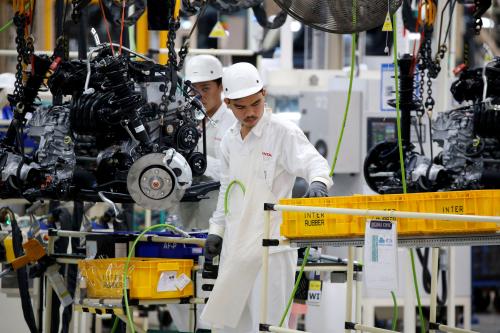 The twin forces of technological change and globalization are reshaping the global economy in multiple and important ways. Nowhere are their effects more pronounced than in labor markets. Considerable attention is now being devoted to analyzing and anticipating changing patterns of employment and wages in advanced economies. Thus far, less focus has been given to understanding the implications for emerging economies.
The twin forces of technological change and globalization are reshaping the global economy in multiple and important ways. Nowhere are their effects more pronounced than in labor markets. Considerable attention is now being devoted to analyzing and anticipating changing patterns of employment and wages in advanced economies. Thus far, less focus has been given to understanding the implications for emerging economies.
The 2016 Brookings Blum Roundtable was convened to take on that agenda. How are the factors driving change in global labor markets playing out differently in developing economies? What are the jobs of the future and how will the terms of employment differ? What skills will those job demand and how will those skills be acquired? And finally, what are the implications of these changes for development prospects and for society?
This essay provides a brief account of the roundtable conversation. It is followed by six essays, authored by leading experts on this topic, that were commissioned to inform the roundtable discussion.
An era of change
The effects of technology—especially digital innovation—and globalization on labor markets are three-fold.
The first effect is disruption as jobs relocate to take advantage of lower costs, evolve to entail different tasks, or undergo wholesale change with the elimination of old jobs and the emergence of new ones. Disruption is a permanent feature of any dynamic economy, the upshot of markets responding to changing conditions. While the effects of disruption can be devastating for any particular individual or community, its effects for workers as a whole are positive if old jobs are replaced with new ones that are safer, less physically arduous, more stimulating, and provide greater autonomy. This has been the case for the median worker in rich economies throughout modern history up until recently, but less true for developing economies.[1] Today’s patterns of disruption are more discriminating, creating new groups of winners and losers, and can no longer be blithely assumed as a net positive. In addition, disruption is believed to be growing in intensity.
Technology has made capital goods cheaper and encouraged their substitution for workers. The result has been a shrinking share of national income accruing as wages as opposed to profits across rich and poor economies.
The second effect is a diminishing role of labor. Technology has made capital goods cheaper and encouraged their substitution for workers. The result has been a shrinking share of national income accruing as wages as opposed to profits across rich and poor economies. Some analysts view this phenomenon in combination with accelerating disruption as inevitably leading toward large-scale technological unemployment. This is an especially alarming prospect in the developing world where demographics are expected to increase the size of the global work age population by half a billion people by 2030. Another possible consequence is to reinforce the trend toward widening inequality.
The third effect is to decentralize economic activity away from corporations to which individuals provide their labor, toward the crowd in which workers participate as micro-entrepreneurs. This phenomenon is a facet of both the digital economy and globalization with the unbundling and contracting out of ancillary services from firms such as accounting and marketing. It is associated with changes in the terms of employment, both positive, such as increased flexibility, and negative, including the decline of unions and weakened workers’ bargaining power, the erosion of norms on pay equity, and reduced job security. These effects are most apparent in rich economies where the formal sector dominates.
While there is good evidence for each of the three effects, their speed and scale is surrounded with uncertainty. For instance, estimates on the share of jobs that are at risk of automation over the medium term vary from 9 to 47 percent for OECD economies; fewer estimates exist for the developing world meaning the possible range is arguably even greater. In another example, a year ago the World Bank reported evidence of the hollowing out of labor markets in the developing world, mirroring the pattern observed in industrialized economies. More recent analysis reveals no such pattern.[2]
Breaking free of a Western lens
One of the challenges in discussing the future of jobs in the developing world is that the jobs agenda and the semantics and metrics that go with it principally reflect a rich economy setting. Without recognition of this, such discussions can easily become divorced from reality.
In the West, being employed means generating an income; those that are not employed are assumed to be either idle or not in a position to take on a paid job. By contrast, individuals recorded as being employed in the developing world typically represent only a small portion of those that are economically active, with the majority instead engaged in low productivity activities in the informal sector. Thus, whereas raising employment in the rich world means moving people into paid employment, in the developing world it entails moving people into more productive—and likely better paid—lines of work.
This has important consequences. In industrialized economies the spread of automation implies the risk of redundancy for many workers. In developing economies, many workers are engaged in economic activities that are already some distance from the technology frontier—in other words, they could feasibly be done with greater technology and efficiency—and are paid accordingly. Automation needn’t imply the loss of that work, but rather the possibility of a further diminishing income. Thus, estimates of the share of jobs at risk of being eliminated in rich and poor economies have different consequences, though both are undoubtedly worrisome.
These differences can also result in labor market conditions in the developing world being mistakenly glorified. For instance, subsistence living in the developing world can be unhelpfully classified as entrepreneurship, implying a degree of choice and value that is clearly lacking. By the same token, subsistence living and informal work share some characteristics with the gig economy in rich economies, despite obvious and important differences.
Distinguishing a jobs agenda from a development agenda
The jobs agenda is increasingly becoming recognized as a priority within developing economies and the international development community.
Despite these challenges, the jobs agenda is increasingly becoming recognized as a priority within developing economies and the international development community. Demand for better jobs and anxiety about the sustainability of livelihoods consistently poll among the top issues in surveys of public opinion, including the vast My World exercise conducted to inform the contents of the Sustainable Development Goals.
At the same time, the development community has struggled to articulate how a jobs agenda differs from support for economic development more generally. This is understandable. Job opportunities in any economy are in part a function of a country’s level of income with poor countries constrained by low domestic demand and investment.
That’s why linking poor economies with consumers and investors in rich countries can be such a powerful force in expanding the range of opportunities for workers—and it is precisely this economic integration that underpins the dramatic economic convergence and poverty reduction in the developing world over the past quarter-century. New technologies have the promise to further expand these linkages, including platforms that couple workers with overseas firms, and, in the near future, instant translation services powered by artificial intelligence. The ability of poor economies to take advantage of these opportunities rests on equipping their workers with sufficient education and skills, as well as access to technology and digital infrastructure.
Even for countries that share the same level of income, the number and quality of jobs can vary significantly with the sectoral composition of their economies. For policymakers seeking to steer their economies toward more labor-intensive sectors, this can present a moving target. Whereas 20 years ago, manufacturing was lauded for its ability to absorb large numbers of relatively unskilled workers and to provide a stepping stone for economies seeking to develop capabilities and move into increasingly productive activities, today service-driven economies with a digital focus such as the Philippines and India may present the most promising and sustainable example to follow.
Just as low income in an economy constrains the number of good jobs that are available, it is also associated with various other adverse characteristics of labor markets including greater job insecurity, limited social protections and high information costs. A credible jobs agenda requires recognizing the constraint of low income and the extent to which it is binding for different labor issues. For instance, the biggest barrier to firms moving into the formal sector is arguably their low productivity and this cannot be divorced from a country’s level of development. By contrast, new technologies can be transformative in reducing information costs in even the poorest economies.
Skills for the future
Education has consistently been associated with high rates of return in both rich and poor economies, but the precise mechanism by which education generates those returns remains somewhat contested. Some view education principally in terms of the imparting of skills while others emphasize its ability to sort individuals by their innate capabilities. The recent emergence of evidence of dismal learning outcomes in schools across large parts of the developing world could be interpreted as swinging the debate more in favor of the latter explanation. That is problematic for a future where the skills demanded of most, if not all, workers are seen as increasingly complex and quickly evolving implying the need for lifelong learning.
Another area of contention is the skills that should be given emphasis in training tomorrow’s workers. If that determination is made narrowly on the basis of the pattern of job creation and elimination, it likely leads to an emphasis on STEM skills. If instead it is made on the basis of the increasing speed of disruption and the changing organization of economic activity toward micro-entrepreneurship, then this raises the importance of soft skills and business skills to help workers adapt to a changing marketplace and to make optimal choices. Workers themselves appear to see the wisdom in this assessment: the most popular course on the online education platform, Coursera, is on “learning to learn.”
Digital technology is ushering in broader changes in the education sector, by threatening to depose those institutions that deliver inadequate outcomes and replace them with ones better suited to the changing global economy. However, we remain a long way from building an ecosystem that can address workers’ needs in assessing capabilities, imparting skills, accrediting skills acquired, and guiding each individual’s trajectory through a path of lifelong learning. A particular institutional gap exists in establishing a credible and secure repository to record each individual’s portfolio of qualifications and capabilities.
As the institutions that dominate the education sector change, this inevitably leads to questions about the role of government in the sector. The enormous positive externalities associated with education would suggest an important role. However, this need not necessarily be as a service provider, but more in shaping policy and providing finance for education. The greatest externalities likely occur for early childhood interventions—an area where government’s role has historically been too limited.
The future of job matching platforms
Another area where digital technology is altering the institutions that shape labor markets is in the process of matching workers with vacancies. This is an exciting area of innovation and invention in the developing world. By linking workers and firms to the information they need, digital job matching platforms can both help markets clear more quickly and induce dynamic responses, including in the content of education programs and in the investment decisions of firms and workers. For example, when Apple adopted the new programming language, Swift, hundreds of freelancers on the digital job platform, Upwork, responded rapidly by training themselves to take advantage of new work opportunities.
A central objective for job matching platforms is to accelerate this feedback loop. That will likely require greater linkages with other actors including those involved in education provision and skill certification. Such partnerships hold enormous potential for transforming labor markets but have yet to be harnessed at scale.
A bolder challenge still is to assist those workers for which matching platforms consistently fail to find job opportunities. Solutions for these individuals may require partnering with NGOs or government, and more complex interventions such as supporting worker relocation.
The consequences of a weak labor movement
While changes in the nature of work associated with the changing global economy are most prominent in advanced economies, there are nevertheless some important patterns shaping the developing world. Perhaps the most prevalent is the absence of a well-defined labor movement in many developing economies and a consequently limited role for collective bargaining. This is notable given what a prominent role these played in securing political goals and improvements in quality of life in the advanced economies during their own process of economic development. Moreover, the effects of technology and globalization appear to be reinforcing this pattern. There is already some early evidence of gig work in the developing world resulting in workers’ rights being less effectively upheld.[3]
There are a number of creative efforts underway to mitigate the negative consequences of these circumstances. For instance, some job matching platforms identify one of their core services to workers as helping them to optimally price their work. However, any attempt to strengthen workers’ bargaining power in an atomized work environment is unlikely to achieve the kind of results won by organized labor. For this reason, some entities focus today on promoting alternative ownership structures to avoid pitting workers against each other and against capital owners.
For most workers in the developing world, a secure job remains only an aspiration. Should the pattern toward decentralized economic activity continue unabated, that possibility may diminish further, even as economies develop and workers enjoy greater earnings. That would fundamentally redefine our idea of what “middle-class” status represents.
Rethinking the role of government
The prospect of greater disruption, a diminished role for labor, and the decentralization of economic activity places a greater onus on the adequacy of safety nets. While safety nets are at different stages of maturity across different countries, those in the developing world have some advantages over those in rich nations in adapting to the needs of a changing global economy. These include programs being less fragmented and more harmonized, and avoiding the constraints that come when benefits are tied too closely to employment.
Compensation forms a central part of most public safety nets, which in its most comprehensive form means a universal basic income. The UBI concept has sparked excited debates in the West over the past year, so it is striking that the most extensive pilot, and one designed with rigorous evaluation in mind, is taking place in Kenya, and that the country arguably most poised to enact a UBI on a national scale is India. Other aspects of safety nets that require more innovative and effective solutions are those focused on retraining and relocating dislocated workers.
The redesign of social safety nets can be understood as one important component of a broader rebalancing required in the social contract between government and citizens, employers and employees, and the winners and losers of the changing global economy. The role of government is not just limited to helping those most vulnerable to change, but shaping change itself, whether by guiding the direction of technology through public investments in research and development, putting in place regulations that foster competitive markets and that are supportive of collective bargaining, and providing digital infrastructure for all.
Perhaps the most fundamental changes government can help usher in concern culture and norms that constrain worker opportunities in the modern global economy. This includes addressing discrimination in hiring and the workplace, removing the negative stigma associated with certain types of jobs, and altering how work is defined to more fully encapsulate all the productive activities by which people define themselves, such as bringing up children and civil participation.
Download the full report »
The Brookings Institution is committed to quality, independence, and impact.
We are supported by a diverse array of funders. In line with our values and policies, each Brookings publication represents the sole views of its author(s).






